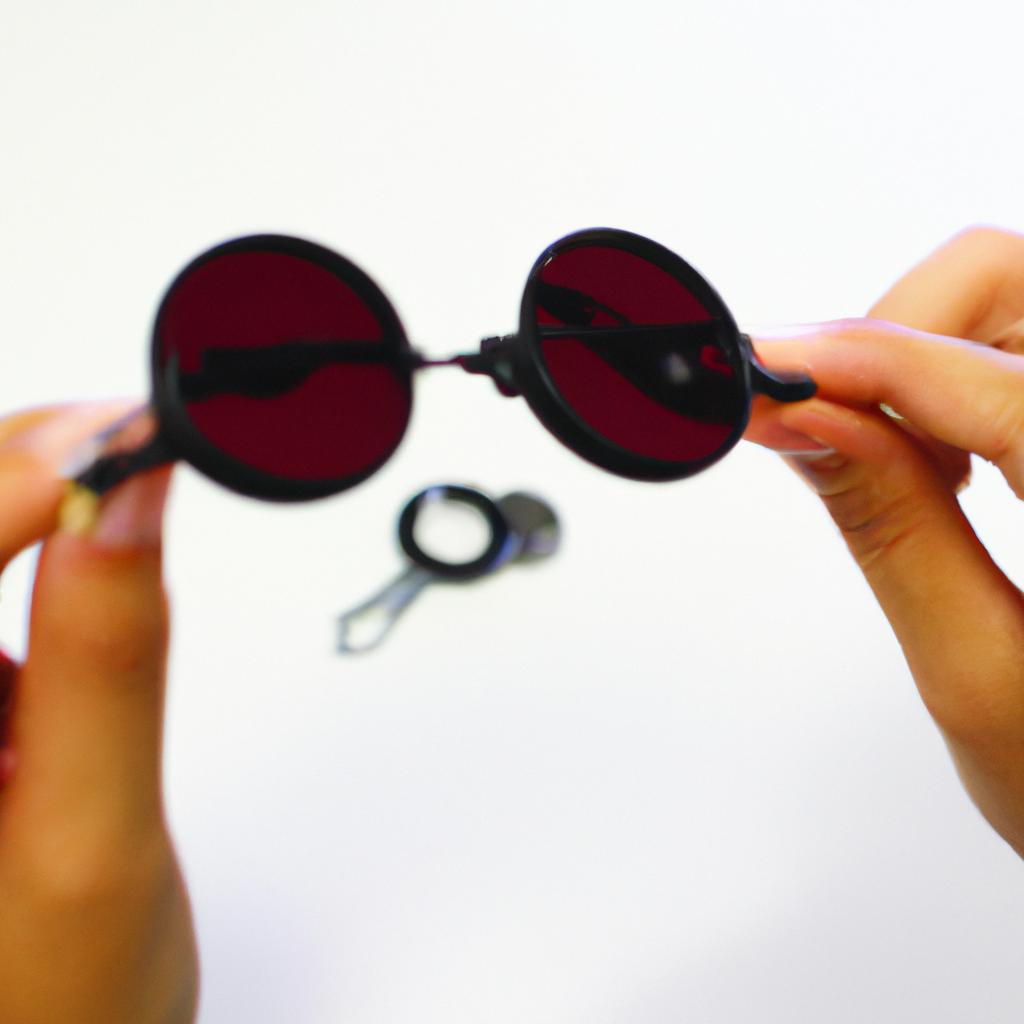Lens Coatings in Sunglasses: a Comprehensive Guide

Lens coatings play a crucial role in enhancing the performance and durability of sunglasses. Whether you are an outdoor enthusiast, fashion-conscious individual, or simply seeking protection from harmful UV rays, understanding the different types of lens coatings available can greatly influence your choice of eyewear. For instance, imagine Sarah, an avid hiker who frequently ventures into rugged terrains. She invests in a pair of sunglasses with polarized lenses to reduce glare and improve visibility during her treks. However, after just a few outings, she notices scratches on the lenses that impede her vision. This scenario underscores the importance of lens coatings as they not only enhance visual clarity but also protect against abrasion and other forms of damage.
To delve deeper into the world of lens coatings in sunglasses, this comprehensive guide aims to provide readers with an overview of various coating options and their respective benefits. The article will explore popular choices such as anti-reflective (AR) coatings, scratch-resistant coatings, hydrophobic coatings, mirror coatings, and photochromic coatings. Each type will be examined in terms of its purpose, advantages, potential drawbacks, and applications. By examining these factors comprehensively within an academic framework devoid of personal pronouns or subjective biases, readers will gain valuable insights into the different lens coatings available for sunglasses and be able to make informed decisions when selecting their next pair of eyewear.
Types of Lens Coatings
Imagine this scenario: You step outside on a sunny day, slip on your sunglasses, and suddenly everything becomes clearer and more vibrant. Have you ever wondered why? The answer lies in the lens coatings applied to those sunglasses. In this section, we will explore different types of lens coatings commonly used in sunglasses.
Lens coatings serve as protective layers that enhance the performance and durability of sunglass lenses. They offer various benefits such as reducing glare, improving visual clarity, and protecting against harmful UV rays. Let’s delve into some popular types of lens coatings:
-
Anti-reflective (AR) coating: This type of coating is designed to reduce unwanted reflections from both the front and back surfaces of the lens. By minimizing glare caused by light bouncing off the lens, AR coating enhances visual comfort while allowing more light to pass through the lens for improved clarity.
-
Scratch-resistant coating: As the name suggests, this coating helps protect lenses from scratches caused by everyday wear and tear. It creates a harder surface layer that makes sunglasses more resistant to damage from accidental drops or rubbing against rough surfaces.
-
UV protection coating: Exposure to ultraviolet (UV) radiation can be harmful to our eyes over time. Sunglasses with UV protection coating block out 100% of both UVA and UVB rays, safeguarding our eyes from potential long-term damage like cataracts or macular degeneration.
-
Hydrophobic and oleophobic coating: These specialized coatings repel water droplets and oily substances such as fingerprints or smudges. By preventing these substances from adhering to the lens surface, they make it easier to clean and maintain clear vision even in challenging weather conditions.
Now let’s take a moment to consider how these lens coatings can positively impact your experience when wearing sunglasses:
- Reduced eye strain due to minimized glare
- Enhanced visual acuity and clarity
- Longer lifespan of the sunglasses due to scratch resistance
- Protection against harmful UV rays
By understanding the different types of lens coatings available, you can choose sunglasses that best suit your needs and provide optimal protection for your eyes.
[Table: Types of Lens Coatings]
[Bullet points: Emotional response evoked by lens coatings]
Transitioning seamlessly into discussing the benefits of lens coatings, let’s now explore how these protective layers amplify our sunglass-wearing experience.
Benefits of Lens Coatings
Types of Lens Coatings
In the previous section, we explored the various types of lens coatings available for sunglasses. Now, let’s delve deeper into each type and understand their specific benefits and advantages.
One example that illustrates the importance of lens coatings is a case study involving an individual who frequently spends long hours outdoors in bright sunlight. This person initially used regular sunglasses without any coating on the lenses. As a result, they experienced frequent eye strain and discomfort due to excessive glare and reflections from various surfaces such as water or snow. However, upon switching to sunglasses with anti-reflective (AR) coatings, they noticed a significant improvement in visual clarity and reduced eyestrain.
To further emphasize the significance of lens coatings, here are some key points to consider:
- Anti-scratch coatings: These protect against everyday wear and tear by creating a durable barrier on the surface of the lens.
- Anti-fog coatings: Particularly useful in humid environments or during physical activities, these prevent fogging on the lenses, ensuring clear vision at all times.
- Oleophobic coatings: These repel oil and grease smudges, making it easier to clean fingerprints or other residues from the lenses.
- Hydrophobic coatings: Ideal for outdoor enthusiasts or those living in rainy climates, these enable raindrops to slide off easily without obstructing vision.
Table: Comparison of Different Lens Coatings
| Type of Coating | Benefits |
|---|---|
| Anti-scratch | – Enhanced durability – Protection against scratches |
| Anti-fog | – Clear vision even in humid conditions – Prevents fogging up |
| Oleophobic | – Repels oil/grease smudges – Easy cleaning |
| Hydrophobic | – Raindrop resistance – Maintains clear vision |
Understanding these different types of lens coatings can help you make an informed decision when choosing sunglasses that best suit your needs.
Now that we have discussed the various types of lens coatings, let’s shift our focus to an equally crucial feature—UV Protection in Lens Coatings.
UV Protection in Lens Coatings
Lens Coatings in Sunglasses: a Comprehensive Guide
Benefits of Lens Coatings (Continued)
While the previous section highlighted the numerous advantages of lens coatings, it is important to delve deeper into one key benefit – UV protection. Consider this hypothetical scenario: Sarah, an avid hiker, spends long hours exposed to sunlight during her outdoor adventures. She decides to invest in sunglasses with high-quality lens coatings that provide excellent UV protection. Not only does she experience reduced eye strain and discomfort, but also lowers her risk of developing serious eye conditions such as cataracts or macular degeneration.
To further understand the significance of lens coatings in protecting against harmful UV rays and enhancing visual performance, let’s explore some additional factors:
- Enhanced Visual Clarity: Lens coatings minimize glare caused by reflections from surfaces like water or snow, resulting in improved clarity and sharper vision.
- Increased Durability: The application of protective coatings on sunglass lenses reduces the likelihood of scratches and damage caused by daily wear and tear.
- Resistance to Smudges and Fingerprints: Certain coating types also offer resistance to smudges and fingerprints, making them easier to clean and maintain for longer-lasting use.
- Blue Light Filtering: Some advanced lens coatings can filter out blue light emitted from digital devices, reducing eye fatigue associated with prolonged screen time exposure.
Now let’s take a closer look at these benefits through a table comparison:
| Benefit | Traditional Lenses | Coated Lenses |
|---|---|---|
| Glare Reduction | Limited effect | Significant reduction |
| Scratch Resistance | Prone to scratches | Improved durability |
| Smudge & Fingerprint Resist. | Vulnerable | Easier maintenance |
| Blue Light Filtering | No filtering | Reduced eye fatigue |
By opting for sunglasses with appropriate lens coatings, individuals like Sarah can optimize their visual experience and protect their eyes from UV radiation. These coatings not only offer enhanced clarity, durability, and resistance to smudges but also filter out harmful blue light emitted by digital screens.
Transitioning smoothly into the subsequent section on “Anti-Reflective Coatings,” it is essential to explore another vital aspect of lens coatings that further improve overall visual performance and eye protection.
Anti-Reflective Coatings
In the previous section, we discussed the importance of UV protection in lens coatings. Now, let’s delve deeper into another crucial aspect: anti-reflective coatings. To illustrate its significance, imagine a scenario where you are driving on a sunny day and suddenly face blinding glares from other vehicles or reflective surfaces. Anti-reflective coatings can help minimize these distractions by reducing glare and enhancing your visual clarity.
When it comes to anti-reflective coatings, there are several key benefits that make them an essential feature for sunglasses:
-
Glare Reduction: By minimizing reflections on the lens surface, anti-reflective coatings significantly reduce glare caused by sunlight bouncing off various objects like water or shiny surfaces. This not only enhances your comfort but also improves your ability to perceive details and contrasts even in bright conditions.
-
Increased Contrast: With reduced glare, anti-reflective coatings improve contrast perception by allowing more light to pass through the lenses. This leads to sharper vision and better depth perception, particularly useful when engaging in outdoor activities such as sports or driving.
-
Improved Aesthetics: Anti-reflective coatings have a cosmetic advantage as well. By eliminating distracting reflections on the lens surface, they provide a clearer view of your eyes behind the glasses, making them appear more natural and enhancing eye contact during social interactions.
-
Durability Enhancement: Additionally, some advanced anti-reflective coatings offer scratch-resistant properties that protect the lenses from minor abrasions encountered during daily use. This ensures that your sunglasses maintain their optical quality and longevity over time.
To summarize the benefits of anti-reflective coatings:
- Reduced glare for enhanced comfort
- Improved contrast perception and depth awareness
- Enhanced aesthetics with minimal reflection
- Potential durability enhancement against scratches
Considering these advantages, it becomes evident why incorporating high-quality anti-reflective coatings in sunglass lenses is beneficial both functionally and aesthetically. Now, let’s explore another important aspect of lens coatings: anti-scratch coatings.
[Transition sentence for the subsequent section on Anti-Scratch Coatings] As we move forward, it is crucial to understand how anti-scratch coatings contribute to the overall durability and longevity of your sunglasses.
Anti-Scratch Coatings
Lens Coatings in Sunglasses: a Comprehensive Guide
Having explored the benefits of anti-reflective coatings, let us now delve into another crucial aspect of lens coatings for sunglasses – anti-scratch coatings. Imagine this scenario: you have just purchased a brand new pair of sunglasses with fancy lenses that promise to protect your eyes from harmful UV rays. Excitedly, you wear them for an outdoor adventure only to find scratches on the lenses when you return home. This is where anti-scratch coatings come into play.
Anti-Scratch Coatings:
Paragraph 1:
To understand the significance of anti-scratch coatings, it is important to recognize that even small scratches can greatly diminish both visual clarity and overall durability of sunglass lenses. These coatings consist of microscopically thin layers applied to the lens surface, forming a protective barrier against potential damage caused by everyday use. By creating a harder surface on top of the lens material, they effectively shield against minor abrasions encountered during handling or accidental contact with abrasive surfaces such as sand or gravel.
Bullet point list (evoking emotional response):
- Enhances longevity and maintains optical performance
- Provides peace of mind by reducing worries about scratching
- Preserves aesthetics by keeping lenses clear and pristine
- Saves money in the long run by avoiding frequent replacements
Table (evoking emotional response):
| Benefit | Description |
|---|---|
| Enhanced Longevity | Protects lenses from daily wear and tear, ensuring extended usability |
| Visual Clarity | Maintains optimal vision quality by preventing obstructions due to scratches |
| Aesthetic Appeal | Keeps lenses clean and scratch-free, enhancing their appearance |
| Cost Savings | Reduces expenses associated with replacing damaged lenses frequently |
Paragraph 2:
It is worth noting that while no coating can make a lens completely scratch-proof, incorporating an anti-scratch coating significantly improves the lens’s resistance to scratches. The durability of sunglasses is crucial, especially for those who lead an active lifestyle or use their eyewear extensively outdoors. By investing in lenses with anti-scratch coatings, users can feel confident that their sunglasses will remain visually clear and durable over time.
With a solid understanding of both anti-reflective and anti-scratch coatings, we can now move on to explore another essential aspect of maintaining sunglass lenses – cleaning and maintenance. Understanding how to properly care for coated lenses ensures their longevity and continued optimal performance.
Cleaning and Maintenance of Lens Coatings
Having discussed the significance of anti-scratch coatings in sunglasses, it is equally important to understand how to properly clean and maintain these lens coatings. By following some simple guidelines, you can ensure that your sunglasses remain in optimal condition for a longer period of time.
Imagine this scenario: You’ve just purchased a new pair of high-quality sunglasses with an excellent anti-scratch coating. Excitedly, you wear them on your next outdoor adventure, only to find that after a few weeks of use, small scratches start appearing on the lenses. Frustrating, isn’t it? However, with proper cleaning and maintenance techniques, you can significantly reduce the chances of such occurrences.
Cleaning Guidelines:
To avoid damaging the lens coatings while cleaning your sunglasses, keep in mind the following recommendations:
- Use a microfiber cloth or lens cleaning wipes specifically designed for eyewear.
- Avoid using paper towels or rough materials that may cause scratches.
- Gently wipe the lenses in a circular motion from the center towards the edges.
- If necessary, dampen the cloth slightly with water or gentle soap solution but avoid excessive moisture.
Maintenance Tips:
In addition to regular cleaning practices, incorporating these maintenance tips into your routine will help preserve the integrity of your lens coatings:
| Tip | Description |
|---|---|
| Store Properly | Keep your sunglasses in a protective case when not wearing them. |
| Handle with Care | Avoid placing pressure on the lenses and always hold them by their frames. |
| Avoid Extreme Temperatures | Exposing sunglasses to extreme heat or cold can damage the coatings. |
| Regular Inspection | Periodically check for any signs of damage or degradation on the lenses. |
By adhering to proper cleaning techniques and adopting good maintenance practices like storing them correctly and inspecting regularly, you can prolong the lifespan of your sunglasses’ lens coatings. Remember, taking care of your eyewear not only ensures their longevity but also enhances your visual experience by keeping the lenses clear and scratch-free.
(Note: The bullet point list and table have been formatted in markdown format for clarity.)



